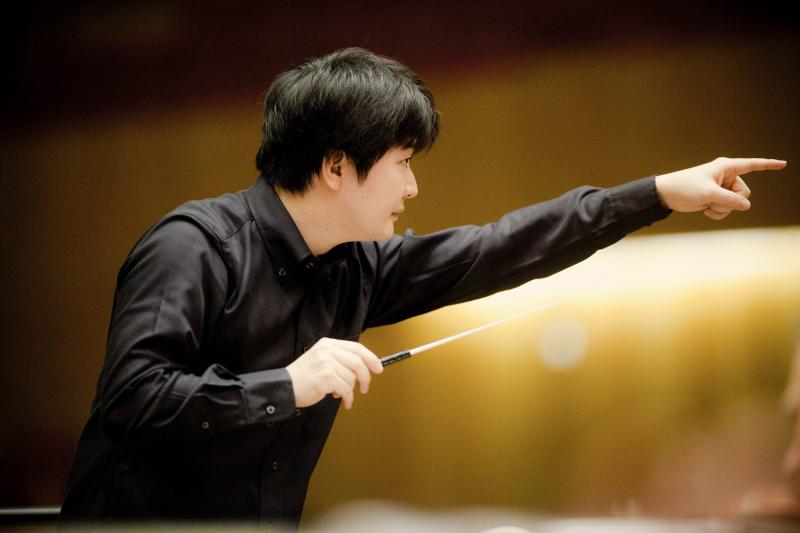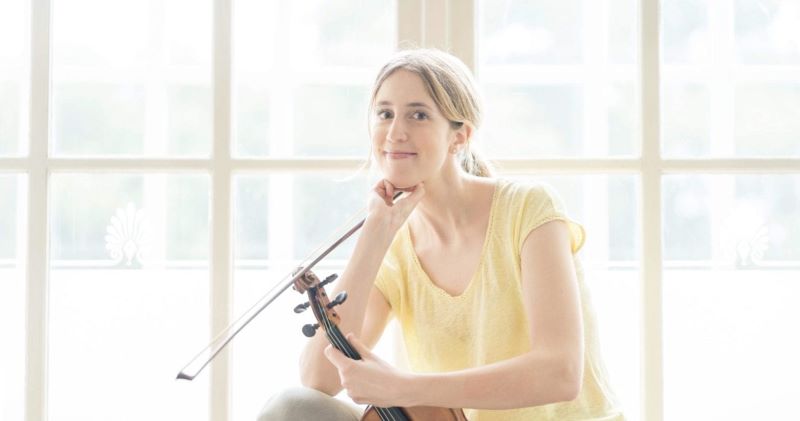Frang, CBSO, Yamada, Symphony Hall Birmingham review - the tingle factor | reviews, news & interviews
Frang, CBSO, Yamada, Symphony Hall Birmingham review - the tingle factor
Frang, CBSO, Yamada, Symphony Hall Birmingham review - the tingle factor
Thoughtful Shostakovich from Vilde Frang, non-stop thrills in Respighi's Roman triptych

There’s a particular moment of a particular recording – I suppose every slightly over-obsessive record collector has one – that I just keep listening to over and over again. It’s in Fritz Reiner’s 1960 Chicago Symphony recording of Respighi’s The Fountains of Rome, and it comes right after the first flood of the Triton Fountain starts to recede.
By that stage in the concert, admittedly, I was experiencing tingles of auditory delight at roughly 20 second intervals. Yamada is the City of Birmingham Symphony Orchestra’s principal guest conductor, and you could see why the musicians like him. If the orchestra’s music director Mirga Gražinytė-Tyla’s supercharged musical intelligence evokes memories of Rattle in Birmingham, Yamada is reminiscent of Andris Nelsons: a smiling, engaging presence who seems to exude music, and who can shape massive sonorities with the wave of a finger. He makes it look so easy: sculpting lush, baroque swirls of sound or sending sensuous quivers through a velvet sheet of string tone. He’s light on his feet too, practically breaking into a boogie in the finale of Respighi's Roman Festivals, and shouting encouragement to a CBSO which – at the end of what were effectively three concertos for orchestra in close succession – sounded as fresh as it had at the start of the evening.
By programming all three of Respighi’s Roman tone poems as one quasi-symphonic triptych, Yamada was clearly playing to his strengths. You might, perhaps take issue with his decision to begin with Roman Festivals and end with The Pines of Rome. The orgiastic final Befana of Roman Festivals – where Respighi grabs huge fistfuls of Petrushka, Die Tote Stadt, Le Sacre du Printemps and Turandot and piles them all up in one ear-splitting, Ivesian sonic collision – is a fairly impossible act to follow. But Yamada kept right on, bright eyed and seemingly determined to make each successive detail of Respighi’s technicolor orchestration out-ravish the last. The miracle was how translucent it sounded – even with offstage brass and organ doing their best to shake the walls down. Mandolin solos, horn calls, Rosenkavalier dissonances and jangling spurts of piano and glockenspiel shone out with hallucinatory brilliance. Still, the depth and delicacy of the quiet music was the real highlight: aided by Yamada’s willingness to let his players fly free, and to back them up with delicate, fluid sensitivity. The closing bars of the Fountains became a whispered cadenza for full orchestra; and in The Pines of the Janiculum clarinettist Oliver Janes shaped his solo with melting softness, while Yamada supported him with cello and bass chords that moved as naturally and as gently as breathing. The final, roof-raising Pines of the Appian Way crowned an evening of some of the most dazzlingly virtuosic orchestral playing I’ve heard this century; but I don’t think the audience’s cheers were just for the loud bits.
Still, the depth and delicacy of the quiet music was the real highlight: aided by Yamada’s willingness to let his players fly free, and to back them up with delicate, fluid sensitivity. The closing bars of the Fountains became a whispered cadenza for full orchestra; and in The Pines of the Janiculum clarinettist Oliver Janes shaped his solo with melting softness, while Yamada supported him with cello and bass chords that moved as naturally and as gently as breathing. The final, roof-raising Pines of the Appian Way crowned an evening of some of the most dazzlingly virtuosic orchestral playing I’ve heard this century; but I don’t think the audience’s cheers were just for the loud bits.
The concert had begun with Shostakovich’s First Violin Concerto – a sombre foil to the Respighi, in which Yamada was noticeably restrained. The result, quite rightly, was to place the soloist Vilde Frang (pictured above) front and centre. Her tone is ripe enough to suggest the old-school Russian intensity of the work’s dedicatee David Oistrakh, but it also has a woody, untamed quality which stood out all the more poignantly against Yamada’s grey, subtly-layered strings and black, loamy bassoons. More to the point was the unaffected assurance of Frang’s playing: her ability to place each phrase exactly where it needed to be, whether in the opening Nocturne (shaped by Frang in a single, singing paragraph) or a finale whose needlepoint brilliance was all the more thrilling for being so masterfully controlled. Again: it’s not always the loud bits that stick in the memory.
rating
Share this article
The future of Arts Journalism
You can stop theartsdesk.com closing!
We urgently need financing to survive. Our fundraising drive has thus far raised £49,000 but we need to reach £100,000 or we will be forced to close. Please contribute here: https://gofund.me/c3f6033d
And if you can forward this information to anyone who might assist, we’d be grateful.

Subscribe to theartsdesk.com
Thank you for continuing to read our work on theartsdesk.com. For unlimited access to every article in its entirety, including our archive of more than 15,000 pieces, we're asking for £5 per month or £40 per year. We feel it's a very good deal, and hope you do too.
To take a subscription now simply click here.
And if you're looking for that extra gift for a friend or family member, why not treat them to a theartsdesk.com gift subscription?
more Classical music
 Bizet in 150th anniversary year: rich and rare French offerings from Palazzetto Bru Zane
Specialists in French romantic music unveil a treasure trove both live and on disc
Bizet in 150th anniversary year: rich and rare French offerings from Palazzetto Bru Zane
Specialists in French romantic music unveil a treasure trove both live and on disc
 Scottish Chamber Orchestra, Ibragimova, Queen’s Hall, Edinburgh review - rarities, novelties and drumrolls
A pity the SCO didn't pick a better showcase for a shining guest artist
Scottish Chamber Orchestra, Ibragimova, Queen’s Hall, Edinburgh review - rarities, novelties and drumrolls
A pity the SCO didn't pick a better showcase for a shining guest artist
 Kilsby, Parkes, Sinfonia of London, Wilson, Barbican review - string things zing and sing in expert hands
British masterpieces for strings plus other-worldly tenor and horn - and a muscular rarity
Kilsby, Parkes, Sinfonia of London, Wilson, Barbican review - string things zing and sing in expert hands
British masterpieces for strings plus other-worldly tenor and horn - and a muscular rarity
 From Historical to Hip-Hop, Classically Black Music Festival, Kings Place review - a cluster of impressive stars for the future
From quasi-Mozartian elegance to the gritty humour of a kitchen inspection
From Historical to Hip-Hop, Classically Black Music Festival, Kings Place review - a cluster of impressive stars for the future
From quasi-Mozartian elegance to the gritty humour of a kitchen inspection
 Shibe, LSO, Adès, Barbican review - gaudy and glorious new music alongside serene Sibelius
Adès’s passion makes persuasive case for the music he loves, both new and old
Shibe, LSO, Adès, Barbican review - gaudy and glorious new music alongside serene Sibelius
Adès’s passion makes persuasive case for the music he loves, both new and old
 Anja Mittermüller, Richard Fu, Wigmore Hall review - a glorious hall debut
The Austrian mezzo shines - at the age of 22
Anja Mittermüller, Richard Fu, Wigmore Hall review - a glorious hall debut
The Austrian mezzo shines - at the age of 22
 First Person: clarinettist Oliver Pashley on the new horizons of The Hermes Experiment's latest album
Compositions by members of this unusual quartet feature for the first time
First Person: clarinettist Oliver Pashley on the new horizons of The Hermes Experiment's latest album
Compositions by members of this unusual quartet feature for the first time
 Gesualdo Passione, Les Arts Florissants, Amala Dior Company, Barbican review - inspired collaboration excavates the music's humanity
At times it was like watching an anarchic religious procession
Gesualdo Passione, Les Arts Florissants, Amala Dior Company, Barbican review - inspired collaboration excavates the music's humanity
At times it was like watching an anarchic religious procession
 Classical CDs: Camels, concrete and cabaret
An influential American composer's 90th birthday box, plus British piano concertos and a father-and-son duo
Classical CDs: Camels, concrete and cabaret
An influential American composer's 90th birthday box, plus British piano concertos and a father-and-son duo
 Cockerham, Manchester Camerata, Sheen, Martin Harris Centre, Manchester review - re-enacting the dawn of modernism
Two UK premieres added to three miniatures from a seminal event of January 1914
Cockerham, Manchester Camerata, Sheen, Martin Harris Centre, Manchester review - re-enacting the dawn of modernism
Two UK premieres added to three miniatures from a seminal event of January 1914
 Kempf, Brno Philharmonic, Davies, Bridgewater Hall, Manchester review - European tradition meets American jazz
Bouncing Czechs enjoy their Gershwin and Brubeck alongside Janáček and Dvořák
Kempf, Brno Philharmonic, Davies, Bridgewater Hall, Manchester review - European tradition meets American jazz
Bouncing Czechs enjoy their Gershwin and Brubeck alongside Janáček and Dvořák
 Solomon, OAE, Butt, QEH review - daft Biblical whitewashing with great choruses
Even a top soprano and mezzo can’t make this Handel paean wholly convincing
Solomon, OAE, Butt, QEH review - daft Biblical whitewashing with great choruses
Even a top soprano and mezzo can’t make this Handel paean wholly convincing

Add comment